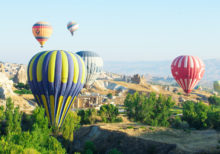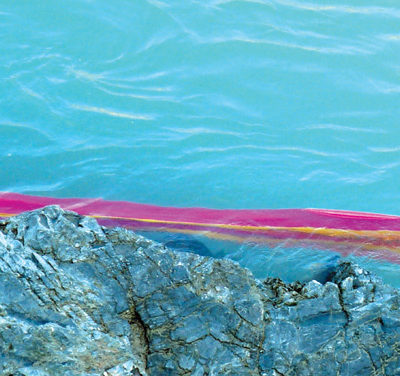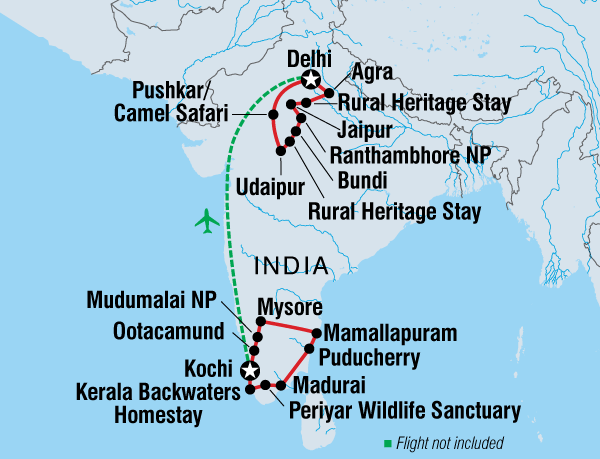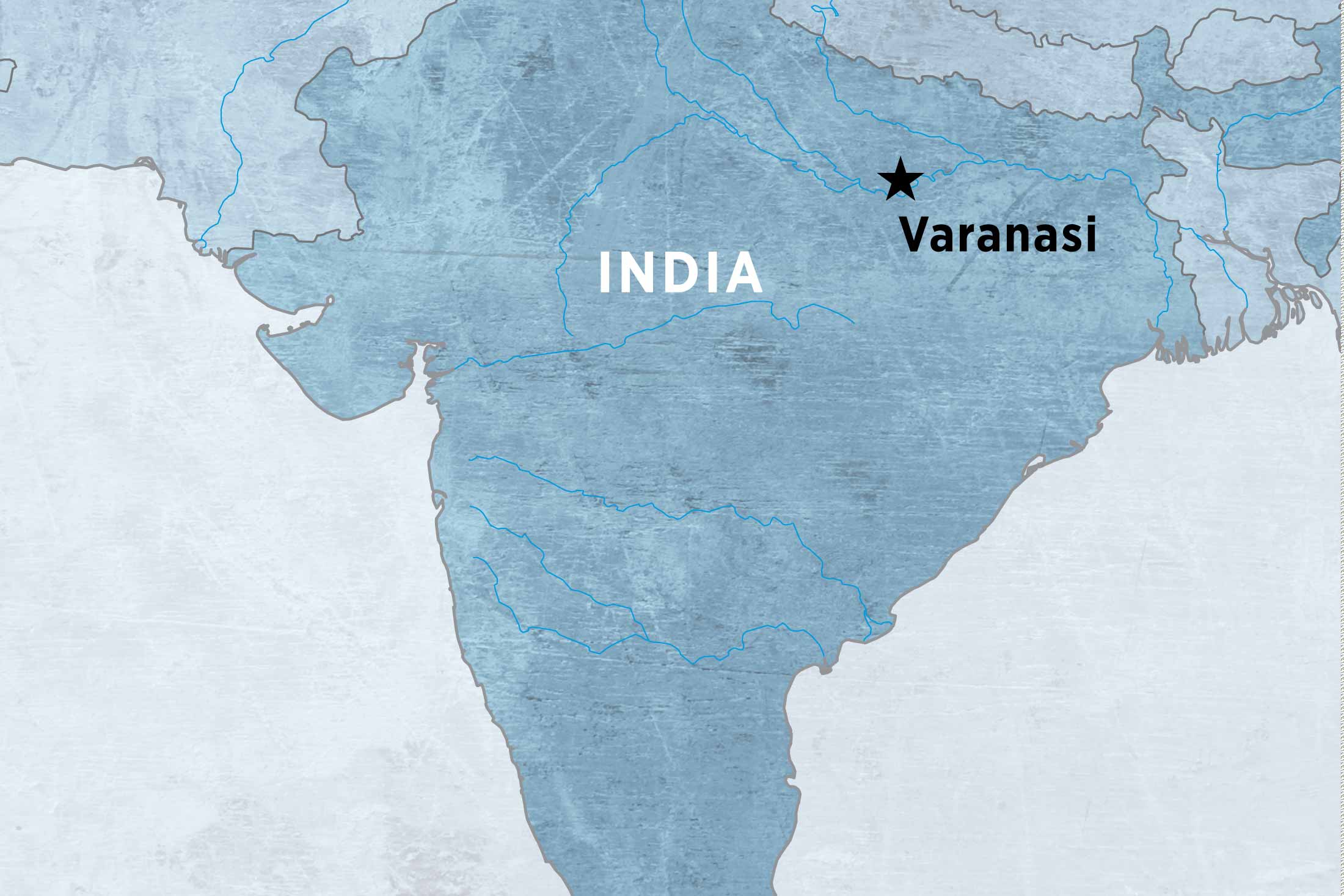| Starts | Delhi, India |
|---|---|
| Ends | Delhi, India |
| Region | India |
| Duration | 15 days |
| Tour Operator | Peregrine |
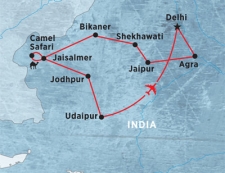
Itinerary
Day 1
Delhi
- Upon arrival you will be collected at the airport by one of our transfer representatives. Your Indian adventure will begin with meeting your local guide.
- India’s capital is a bustling, exciting and often chaotic hub, filled with fascinating historical sites, galleries, museums and incredible bazaars.
- There are a number of sites worth seeing in your free time. The 1570 Mughal masterpiece of Humayun’s Tomb is a World Heritage-listed site. It was the first garden tomb in India.
- The tall brick minaret of Qutub Minar was crafted in the 1100s; it is a fascinating site to explore. You may also like to visit the mighty Red Fort of Delhi. This part-palace, part-fort has hosted a variety of guests ranging from British soldiers to royal families.
- Your guide will take you on an organised sightseeing trip through Old Delhi via the city’s modern metro, you will then have the chance to test India’s iconic cycle rickshaw with an adventure through the chaotic streets, including Chandni Chowk.
- You may also see the oldest mosque in Delhi, Jama Masjid, an impressive structure, before visiting the Sikh temple, Sheeshganj Gurudwara.
Day 2
Agra
- Today you will experience one of India's faster air-conditioned trains on your way to the Mughal city of Agra (approximately 3 hours).
- Agra is the home of one of the world's most recognisable monuments, the Taj Mahal.
- You will have the opportunity to do a cycle rickshaw tour of the city, a wonderful way to uncover the best of Agra. Please note that in the case of a particularly hot or foggy day, the cycle rickshaw tour will be replaced with battery-powered rickshaws.
- Next you will visit the spectacular Taj Mahal - a masterpiece of shimmering white marble set amid beautiful formal gardens. This amazing 17th century marble mausoleum was built by Emperor Shah Jahan as a tomb for his second wife, who died giving birth.
- Started in 1631, the project was completed in 1648 and employed a workforce of over 20,000 people. Construction materials were brought from all over India with the marble from Rajasthan transported by over 1000 elephants. The Taj has been described as a 'teardrop on the face of eternity' (by writer Rabindranath Tagore).
- You will also visit the nearby Agra Fort - a huge complex built originally as a military structure of red sandstone by Emperor Akbar in 1565, and partially converted into a palace during the time of Shah Jahan.
Day 3-4
Fatehpur Sikri - Jaipur
- Today you will rise early and leave for Jaipur. Your first stop will be the deserted Mughal kingdom of Fatehpur Sikri (approximately 1.5 hrs). This magnificent ghost town was capital of the Mughal Empire between 1571 and 1585. Built during the reign of Emperor Akbhar it was abandoned shortly after his death due to a lack of available water. The stunning mosque, Jama Masjid, is a feature of the settlement. It captures both Persian and Hindu design, and has an impressive 54-metre-high main entrance called Buland Darwaza (Gate of Victory), which commemorates Akbar’s great victory in Gujarat.
- You will stop for a traditional thali lunch en route to Jaipur.
- Jaipur is the colourful capital of the state of Rajasthan, and a vibrant and exciting town.
- Here, traditionally dressed Rajput men wearing colourful turbans and sporting magnificent moustaches will make their way through crowded streets packed with cars, camel carts, rickshaws, trucks, and bicycles. You will also find bustling brightly coloured bazaars filled with handcrafted textiles, folk art, and semi-precious stones, the local specialty. Jaipur is a favourite among travellers.
- You will then travel 11 kilometres out to the stunning medieval Amber Fort. This fort was built in 1592 by Maharajah Man Singh and is a superb example of Rajput architecture. Several hours are needed to explore this huge fortification.
- Next you will have the opportunity to explore the various rooms and apartments of Jaipur's Royal City Palace - one of India's finest.
- Continue to indulge in the wonders of Indian culture by watching a Bollywood blockbuster, action, romance, drama and music (sometimes all rolled into one), at the spectacular Raj Mandir Cinema.
- You will also see one of five astronomical observatories built by Maharaja Jai Singh, the founder of Jaipur.
- For many travellers a hot air balloon experience is one of the highlights of Jaipur. Ballooning can be done over Jaipur on the morning of day 4 between Sep & Jun. For additional information please see the important notes section of your trip notes.
Day 5-6
Mandawa
- Today you will drive from Jaipur to Shekhawati (approximately 5 hours). Shekhawati is a remote town in the centre of the Shekhawati region. Ancient caravans used to stop in Mandawa en route to the Middle East and China. It was a trading outpost and in 1755 Thakur Nawal Singh, the Rajput ruler of Nawalgarh and Mandawa, built a fort to protect it.
- You will wonder through this fascinating town, which is often referred to as an outdoor museum, and uncover Mandawa's ornate havelis (private residences). Some of these are crumbling and others are wonderfully restored and preserved.
- While in Mandawa we pay a visit to one of our Responsible Travel Projects - Asha Ka Jharna. This wonderful organisation provides services to children and adults with disabilities and the most vulnerable in society. We visit one of their three schools where special and vocational education, guidance and counselling are provided to around 160 children, helping them to become self-dependent rather than their disability causing a burden on their families. We have a chance to meet and chat with some of their teachers to hear about the fantastic work they do in providing opportunities for the children to learn and develop and ultimately become valued members of society.
- Asha Ka Jharna is supported by The Intrepid Foundation and any donation you make through our website will be matched dollar for dollar.
- http://www.theintrepidfoundation.org/projects/asha-ka-jharna/
Day 7
Bikaner
- From here you will by travel deeper into the Thar Desert to the fortified town of Bikaner (approximately 5 hours driving). Bikaner was an important staging post on some of the great caravan routes, and thus houses a multitude of bazaars along with an impressive fort and palace.
- You will travel to the 600-year-old Karni Mata temple next. The temple is notable for the proliferation of rats that live there, thought to be the reincarnation of followers of the Hindu goddess Durga. Locals consider a holy rat running over your bare feet to be particularly auspicious, so if you're not a vermin lover, it might be an idea to stay outside.
- After you have met the holy rats, you will continue on to Junagarh Fort, originally built by Raja Rai Singhji, the sixth ruler of Bikaner (1571 to 1612 AD).
- As night falls you will travel to a nearby farm and partake in a special evening of traditional Rajasthani food, music and dance.
Day 8-10
Jaisalmer - camel safari
- Today you will wind along a remote desert road to the yellow sandstone citadel of Jaisalmer (approximately 7 hrs).
- It rises from the arid, flat desert like a vision from 'One Thousand and One Nights'. Explore the twisted lively alleyways of Jaisalmer, filled with markets and ornately carved houses.
- Located on the banks of Garsisar Lake in the Mehar Bagh Garden, is the Jaisalmer Folklore Museum. It is home to a variety of exhibits.
- Finish the day with one of the highlights of the trip, a camel safari (approximately one hour) out to the pristine sand dunes of the Thar Desert. You will spend a night camping out under the stars in tents.
Day 11
Jodhpur
- Today you drive across the desert to discover Rajasthan's second-largest city, the busy and chaotic Jodhpur (approximately 6 hours).
- Jodhpur abounds in antique shops, and is alleged to have the best lassi in India. It is also where the famous Jodhpur trouser originated.
- While you are in Jodhpur you will have the opportunity to explore the colossal Mehrangarh Fort. A highlight of the fort is the expansive views from its ramparts,
- In your free time you can visit India's last great palace, the Umaid Bhawan Palace. The palace was built in the years between 1929 and 1944. It was named for Maharaja Umaid Singhji, and his successors still reside there.
Day 12-13
Udaipur
- From Jodhpur you will travel through the beautiful hamlet of Ranakpur (approximately 3 hours). Ranakpur is the home of a host of elaborately carved white marble Jain temples.
- The temples are incredibly complex, they lure Jain pilgrims from across India, making Ranakpur one of the most important pilgrim destinations for Jains in India.
- From here will you will continue on your journey to Udaipur (approximately 5 hours).
- Udaipur is known as India's most romantic city. The rolling hills, white marble palaces, and sprawling lakes of the region combine to great effect. Like the other romantic cities of the world, Udaipur is a hub for artists, dancers and musicians. Miniature paintings are a great shopping attraction of the region, as well as silver, leather and shoes.
- You will have the opportunity to meander through the undulating laneways of Udaipur to get a feel for the city and to discover the shops, you will also visit the City Palace, one of the largest royal palaces in India. It is home to a host of treasures and antiquities, from vivid murals to antiques and royal utensils.
- To ensure you are completely immersed in the romance of the city, you will then take a half-hour boat ride on the famous Lake Pichola. From here you might see marvels like Lake Palace and Jag Mandir Island (this will depend upon the water level in the lake at the time of your visit).
- You will also have the chance to be involved with a local musical concert combining seven traditional Rajasthani folk dances before indulging in a famous Spice Box cooking class. You will spend half the day learning and preparing the secrets of Indian cuisine.
Day 14-15
Delhi
- Today you will take a flight to Delhi (approximately 1.5 hrs arriving around 5:30pm), where you will be collected and delivered to a comfortable hotel for your final night of the tour. The final day of the trip will be free, so you can choose to continue to explore Delhi or arrange your onward travel at any time.
- If you planning to spend more time in Delhi, there is much to see. Raj Ghat is a monument that marks the spot where Mahatma Gandhi was cremated. It is now incorporated into the National Gandhi Museum. Hauz Khas Village is a great place to escape the hustle and bustle of downtown - a chic artistic enclave set right next to the remnants of a historical site.






